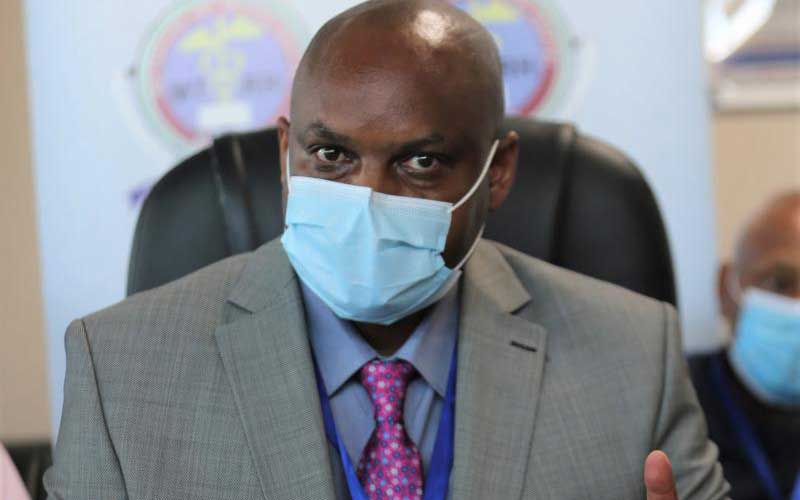
Moi Teaching and Referral Hospital CEO Wilson Aruasa, when he addressed the press at his office, yesterday. [Peter Ochieng, Standard]
When Peter Kamau, a commercial photographer in Eldoret town was knocked dead by a vehicle, those who knew him were surprised when public health officers in full personal protective equipment (PPE) took charge in removal of the body from the Moi Teaching and Referral Hospital (MTRH) mortuary and subsequent burial at Kiplombe cemetery.
To them, Kamau died in a car accident and not of Covid-19 as it was put in play in the public, and they even went to bash MTRH for allowing public health officers to bury him instead of the deceased’s family.
Kiplangat Kirui, one of Kamau’s friends, was annoyed by the sudden turn of events and dismissed existence of the disease.
“I have no doubt that there is corona, but our colleague was knocked down by a matatu while trying to evade police officers during curfew time but today we are told he died of corona,” posted Kirui in a social media platform accompanied by pictures of his friend’s burial.
SEE ALSO: Health CS turns to Facebook magic as ouster calls intensify
Castigated move
Goddy Hulian echoed; “Scammers no corona, these people are making money. Kenya needs faith.” What Kirui and his colleagues do not know however is that Kamau who lived at Langas slums was indeed infected with the viral disease but was asymptomatic.
MTRH boss Wilson Aruasa told The Standard he was not surprised when the public castigated the move to bury Kamau in strict conformity with Covid-19 protocols, yet he was a road accident victim.
“Yes, the body was brought in by police and booked at the farewell home as an accident victim. This was purely an incidental case. And before we preserved the body, we took samples for Covid-19 and the results came out positive.
“So there was nothing like foul play as the public and his family alleged,” said the MTRH CEO. He said as a public safety practice, all bodies are subjected to coronavirus test before being booked at the farewell home because it has been found that the dead actively transmit the virus.
SEE ALSO: Airline spared auctioneer’s hammer over Sh1.3b debt
“With the advent of the novel viral disease we want to protect our staff and even the deceased’s relatives so in our farewell home we have strict protocols that should be followed which is not limited to posthumous Covid-19 testing,” said Dr Aruasa.
He said following confirmation of Kamau’s case, they embarked on contact tracing and so far 10 people including the deceased’s family members have tested positive.
“Stigma associated with Covid-19 is still rife. At the moment there are rampant community transmissions but members of the public are in denial and do not want to be associated with anyone diagnosed with the disease and it explains why they denied Kamau was infected,” he said.
Kamau’s case illustrates how coronavirus has changed burial rites unlike before when relatives acted as pallbearers and helped lower the casket into the grave. But Aruasa said once a body is identified as Covid-19 positive, it is kept in isolation.
“We have an isolation chamber with a carrying capacity of 24 bodies.
SEE ALSO: Covid-19 cuts imports by 20pc as businesses grind to a halt
This is where we isolate the positive cases awaiting burial,” he said. He said so far they have tested 103 bodies, and eight turned positive for coronavirus.
MTRH Pathologist Dr Benson Macharia, said they have put in place measures in strict conformity with the World Health Organisation, Centre for Disease Control and Prevention as well as Ministry of Health guidelines in regard to body disposal.
“Reports documented indicate coronavirus has been transmitted by dead bodies; what we do not know yet is how long the virus survives. Bodies kept in a fridge have been found to keep the virus as long as it is there,” he said.
MTHR acting head of Public Health Julius Cherop said the disease had altered the burial of an individual.
“Before a body is put in a coffin, it should be under two layers of body bags and only public health officials should ferry the body from the morgue and conduct the burial. The body must remain in the hearse till the time of lowering it to the grave,” he said.
This, he explained, is meant to reduce the chances of transmission and any waste generated should be burned on site or brought to a health facility for incineration.
Credit: Source link